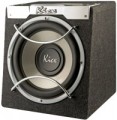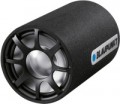Enclosure type
—
Closed box. The simplest type of case: a box closed on all sides with a speaker (speakers) on the front panel. The advantages of such models are high accuracy of sound transmission and low cost, the disadvantages are low sensitivity and somewhat “flat” bass.
—
Phase inverter. A classic phase inverter is a hollow tube connecting the internal volume of the case with the outside world (however, there are other options for such a connection). The length of the phase inverter channel is chosen so that the sound waves of a certain range, passing through it, are inverted in phase relative to the waves from the speaker (hence the name). This improves (in particular, "deepens") the sound of the subwoofer and allows you to achieve good performance with a small cabinet size. On the other hand, the sound stream in the tube creates a certain additional noise.
—
Strip. A design that combines the features of a closed box and a bass-reflex enclosure. One of its parts is made closed, and the second is equipped with a phase inverter tube; between them is a partition, on which the main speaker is located. Unlike previous types, the speaker is entirely inside the case. Strip-line enclosures provide louder sound than boxes or bass reflexes, with sound quality comparable to the latter. The disadvantage is the complexity of the design, as a result — a slightly higher price.
Body shape
—
Case Box. Literally "box". The simplest type of case, in fact, is a box of medium dimensions, designed for installation in the boot.
— Compact. This option means rather than the shape, but the size of the case — as the name implies, it includes devices that have small dimensions. Such subwoofers are as simple as possible to install, some models can be installed directly
under the seat. At the same time, their sound quality and power are usually lower than those of full-size ones.
— Tube. The case is in the form of a pipe, on one of the ends of which a speaker is displayed. This form does not significantly affect the sound characteristics, it plays mainly an aesthetic role —
subwoofers-pipes look quite stylish.
Type
—
Active. Subwoofer equipped with its own built-in amplifier. Such a subwoofer can be connected directly to the signal source, without any additional amplifiers; while the built-in amplifier, by definition, has characteristics that best match the parameters of the speaker. And when using other amplifiers, an active subwoofer reduces the load on them, which has a positive effect on sound quality and power. In addition, your own amplifier can be equipped with its own sound tuning tools and other additional features. On the other hand, all this affects the cost of the device, and active models are somewhat more difficult to install, because. require separate power supply.
—
Passive. Subwoofers not equipped with their own amplifier. They are cheaper than active ones and easier to install. work without a separate power supply, however, the connection is fraught with some difficulties: for normal operation, an amplifier is needed, the characteristics of which (in particular power and impedance, see below) must optimally match the parameters of the subwoofer.
Rated power
The average (root mean square — RMS) power of the input signal, at which the subwoofer is able to work continuously without negative consequences (damage, failure) for at least an hour. The rated power of the subwoofer must be greater than the power of the amplifier connected to it — in order to avoid overloads.
Max. power
The maximum signal power that the subwoofer is able to withstand for a short time (up to several seconds) without any negative consequences. When selecting an amplifier-subwoofer pair, it is recommended to take a subwoofer with a maximum power of at least twice the maximum power of the amplifier. In general, the higher the maximum power, the more resistant the subwoofer is to overloads.
Frequency range
The range of audio frequencies reproduced by the subwoofer. It is believed that the human ear is capable of perceiving a frequency range of the order of 16 – 20,000 Hz, but in this case note that the subwoofer is designed to reproduce the lower frequency band (up to 200 Hz). Accordingly, in the case of the lower limit of the range, everything is simple: “the lower, the better”; the upper one should not be lower than the lower limit of the main car audio — otherwise there will be "gaps" in the frequencies, which will affect the sound quality.
Sensitivity
Sensitivity determines the loudness of the subwoofer when a signal of a certain power is connected to it: with equal signal power and impedance (see below), the subwoofer with the higher sensitivity will sound louder.
Resonant frequency
The natural frequency of the cone in the subwoofer speaker, namely the frequency with which the cone will oscillate if the speaker is suspended freely in the air and a single impulse is transmitted to the cone (for example, by clicking on it with your finger). In subwoofers, this parameter determines, in particular, the lower limit of the frequency range (see above): at frequencies below the resonant sound power drops sharply. Accordingly, for deep rich bass, the resonant frequency should be as low as possible. This parameter is also used to calculate the size of the enclosure for the subwoofer.
Bass level control
Since the subwoofer was originally designed to reproduce bass, in fact, in this case, it implies the presence
of its own volume control, which allows you to change it without affecting the signal source. This allows you to easily set the desired bass level relative to the rest of the sound of the audio system (for different cases, this ratio may be different).

